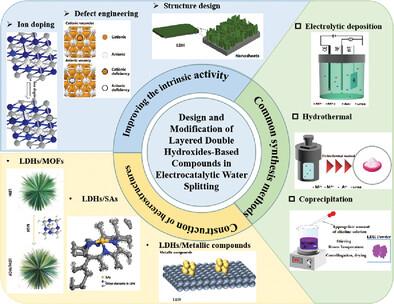Design and Modification of Layered Double Hydroxides-Based Compounds in Electrocatalytic Water Splitting: a Review
IF 13
2区 材料科学
Q1 CHEMISTRY, MULTIDISCIPLINARY
引用次数: 0
Abstract
Layered double hydroxides (LDHs) exhibit great potential in electrocatalytic water splitting due to the unique 2D feature and an adjustable structure composed of different metal centers. In addition, LDHs have the advantage of being inherently inexpensive compared to other catalysts and have good stability in electrocatalytic water splitting. Up to now, numerous methods have been put forward to improve the activity of LDHs in electrocatalytic water splitting, a comprehensive introduction and comb to the fabrication methods and modification strategies is helpful for the followers to get a clear vein to carry out efficient manipulation to the development of high promising LDHs catalysts. In this review, the basic principles of water electrolysis, and the evaluation indexes are introduced first, and then the basic properties and commonly utilized methods in the fabrication of LDHs are introduced. After that, the oxygen evolution reaction (OER), hydrogen evolution reaction (HER), and overall water splitting (OWS) performance of different LDHs-based catalysts and analyze the merits and shortcomings of LDHs in electrocatalytic water splitting is compared. Based on this, the advanced strategies for improving the performance of LDHs is introduced and give a brief prospect for the development of LDHs-based materials in electrocatalysis.

求助全文
约1分钟内获得全文
求助全文
来源期刊

Small
工程技术-材料科学:综合
CiteScore
17.70
自引率
3.80%
发文量
1830
审稿时长
2.1 months
期刊介绍:
Small serves as an exceptional platform for both experimental and theoretical studies in fundamental and applied interdisciplinary research at the nano- and microscale. The journal offers a compelling mix of peer-reviewed Research Articles, Reviews, Perspectives, and Comments.
With a remarkable 2022 Journal Impact Factor of 13.3 (Journal Citation Reports from Clarivate Analytics, 2023), Small remains among the top multidisciplinary journals, covering a wide range of topics at the interface of materials science, chemistry, physics, engineering, medicine, and biology.
Small's readership includes biochemists, biologists, biomedical scientists, chemists, engineers, information technologists, materials scientists, physicists, and theoreticians alike.
 求助内容:
求助内容: 应助结果提醒方式:
应助结果提醒方式:


